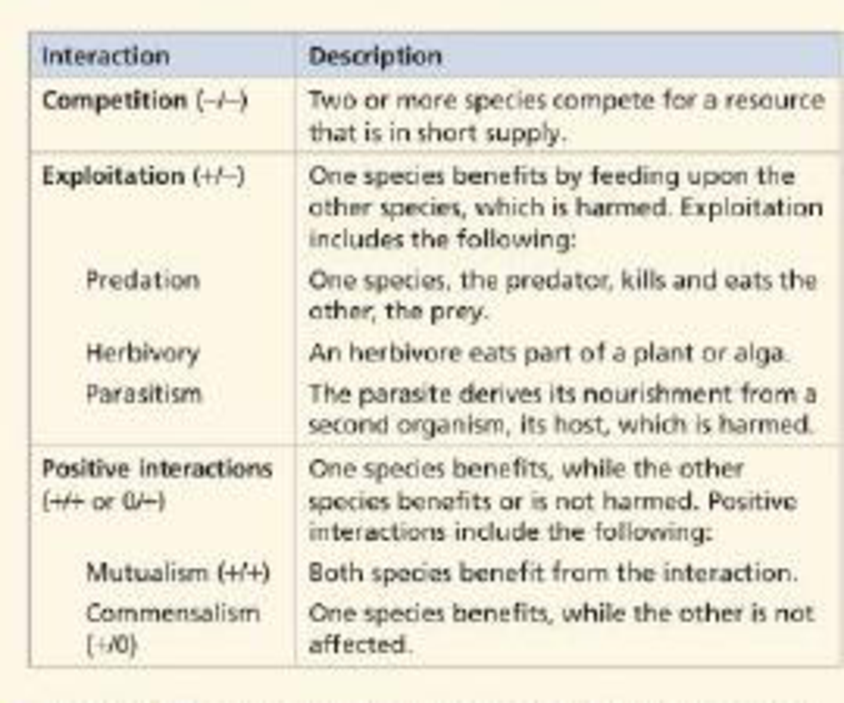
Concept explainers
Interspecific interactions affect the survival and reproduction of the species that engage in them. As shown in the table, these interactions can he grouped into three broad categories: competition, exploitation, and positive interactions.

Competitive exclusion states that two species competing for the same
For each interaction listed in the table, give an example of a pair of species that exhibit the interaction.
To provide: Examples of species involved in different types of interspecific interactions.
Concept introduction: Interspecific interactions refer to the relationship that exists between members of different species of a biological community. It includes commensalism, parasitism, herbivory, predation, competition, and others. These interactions can have either positive or negative impact on the survival of species engaged in the interaction.
Given data: Refer to the table in the concept 54.1 “ Community interactions are classified by whether they help, harm, or have no effect on the species involved”, in the textbook.
Explanation of Solution
The interspecific interactions can be classified into three categories, namely, positive interactions, competition and exploitation.
The positive interaction is a type of interaction in which one species are benefitted and the other may or may not get benefits but is never harmed.
The competition is a type of engagement where both the species are affected (harmed) as they share a common resource (short in supply).
In exploitation, one species get benefit while the other is affected negatively (harmed).
The positive interactions include mutualism and commensalism. On the contrary, exploitation involves predation, parasitism and herbivory.
Interactions along with its examples are tabulated as follows:
| Type of interactions | Examples |
| Competition | Lynx and foxes of Alaska (compete for snowshoe hares) |
| Exploitation | |
| Predation | Lion (predator) and antelope (prey) |
| Herbivory | Rice grasshopper (herbivore) and rice plant (act as food) |
| Parasitism | Plasmodium(parasite) and human (host) |
| Positive interactions | |
| Mutualism | Acacia and ant (both benefit each other) |
| Commensalism | Cattle egrets (get a benefit)and African buffalo (not harmed) |
Want to see more full solutions like this?
Chapter 54 Solutions
Campbell Biology
- You intend to insert patched dominant negative DNA into the left half of the neural tube of a chick. 1) Which side of the neural tube would you put the positive electrode to ensure that the DNA ends up on the left side? 2) What would be the internal (within the embryo) control for this experiment? 3) How can you be sure that the electroporation method itself is not impacting the embryo? 4) What would you do to ensure that the electroporation is working? How can you tell?arrow_forwardDescribe a method to document the diffusion path and gradient of Sonic Hedgehog through the chicken embryo. If modifying the protein, what is one thing you have to consider in regards to maintaining the protein’s function?arrow_forwardThe following table is from Kumar et. al. Highly Selective Dopamine D3 Receptor (DR) Antagonists and Partial Agonists Based on Eticlopride and the D3R Crystal Structure: New Leads for Opioid Dependence Treatment. J. Med Chem 2016.arrow_forward
- The following figure is from Caterina et al. The capsaicin receptor: a heat activated ion channel in the pain pathway. Nature, 1997. Black boxes indicate capsaicin, white circles indicate resinferatoxin. You are a chef in a fancy new science-themed restaurant. You have a recipe that calls for 1 teaspoon of resinferatoxin, but you feel uncomfortable serving foods with "toxins" in them. How much capsaicin could you substitute instead?arrow_forwardWhat protein is necessary for packaging acetylcholine into synaptic vesicles?arrow_forward1. Match each vocabulary term to its best descriptor A. affinity B. efficacy C. inert D. mimic E. how drugs move through body F. how drugs bind Kd Bmax Agonist Antagonist Pharmacokinetics Pharmacodynamicsarrow_forward
- 50 mg dose of a drug is given orally to a patient. The bioavailability of the drug is 0.2. What is the volume of distribution of the drug if the plasma concentration is 1 mg/L? Be sure to provide units.arrow_forwardDetermine Kd and Bmax from the following Scatchard plot. Make sure to include units.arrow_forwardChoose a catecholamine neurotransmitter and describe/draw the components of the synapse important for its signaling including synthesis, packaging into vesicles, receptors, transporters/degradative enzymes. Describe 2 drugs that can act on this system.arrow_forward
- The following figure is from Caterina et al. The capsaicin receptor: a heat activated ion channel in the pain pathway. Nature, 1997. Black boxes indicate capsaicin, white circles indicate resinferatoxin. a) Which has a higher potency? b) Which is has a higher efficacy? c) What is the approximate Kd of capsaicin in uM? (you can round to the nearest power of 10)arrow_forwardWhat is the rate-limiting-step for serotonin synthesis?arrow_forwardWhat enzyme is necessary for synthesis of all of the monoamines?arrow_forward
 Biology Today and Tomorrow without Physiology (Mi...BiologyISBN:9781305117396Author:Cecie Starr, Christine Evers, Lisa StarrPublisher:Cengage Learning
Biology Today and Tomorrow without Physiology (Mi...BiologyISBN:9781305117396Author:Cecie Starr, Christine Evers, Lisa StarrPublisher:Cengage Learning Biology (MindTap Course List)BiologyISBN:9781337392938Author:Eldra Solomon, Charles Martin, Diana W. Martin, Linda R. BergPublisher:Cengage Learning
Biology (MindTap Course List)BiologyISBN:9781337392938Author:Eldra Solomon, Charles Martin, Diana W. Martin, Linda R. BergPublisher:Cengage Learning Concepts of BiologyBiologyISBN:9781938168116Author:Samantha Fowler, Rebecca Roush, James WisePublisher:OpenStax College
Concepts of BiologyBiologyISBN:9781938168116Author:Samantha Fowler, Rebecca Roush, James WisePublisher:OpenStax College





